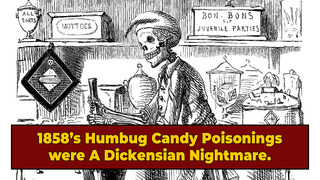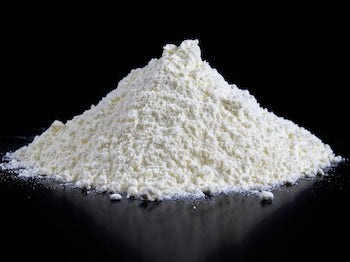Victorian-Era 'Willy Wonka' Gave Kids Poisoned Candy

Windowless vans notwithstanding, is there anything more innocent than enjoying a piece of candy? But in Victorian England, these innocuous sweets caused one of the greatest mass poisonings in the country's history, all because no one knew the difference between tasty plaster and rat poison.
This is the story of Humbug Billy, a name that evokes fingerless gloves and the most yellow of British teeth. William "Billy" Hardaker was one of Bradford, Yorkshire's premium purveyors of humbugs, a kind of peppermint lozenge you'll still find petrifying at the bottom of your grandma's sweets jar. Of course, when I say "premium," I meant cheap, as Humbug Billy supplied his sweets to the impoverished children of Bradford. But it wasn't easy to make cheap candy in Victorian Britain. By the 19th century, heavily taxed British sugar was such a prized commodity; it was referred to as "white gold." And just like cocaine (we were all thinking that, right?), only the upper crust could afford to lace their pies with a whole kilo of this West Indies marching powder.
Don't Miss
Lower-class vendors like Humbug Billy would order sweets from less than scrupulous confectionery makers to cut back on costs. These cut-rate Willy Wonkas would cut their precious sugar supply with a substance called daft, a mixture of ground limestone and gypsum that was still more nutritious than the gruel their chimney sweeping customers would eat. Billy's contact, Joseph Neal, would get this Humbugger Helper from a local pharmacy. But during one daft run, Neal had to deal with a less than competent pharmacist's assistant, who only knew that daft was a fine, white, tasteless powder. And you know what else is a fine, white, tasteless powder? Just about everything that has caused government buildings to evacuate when the mail came in.

On that fateful day in 1858, Humbug Billy didn't know that, instead of selling daft-laced humbugs, he was selling them laced with arsenic trioxide -- each candy containing several times the lethal dose of this toxin. After only one day of sweet sales, over 200 people became rat-poisoned, including Humbug Billy, who always got a sugar high off his own supply. Young urchins started dropping like flies, with 21 humbug-related deaths being recorded in the aftermath. Humbug Billy, Neal, and several other accomplices were brought up on charges of mass manslaughter but were let off the hook due to their obvious incompetence.
The mass poisonings caused such an outrage in Britain, it did lead to several legal reforms. The 1860 Adulteration of Food and Drink Bill and Pharmacy Act of 1868, both some of the earliest precursors to modern Food and Drink regulatory bodies, making sure that, from now on, our candies could only contain safe amounts of toxic rat poison.
For more jolly old tangents, do follow Cedric on Twitter.
Top Image: Punch via Wikimedia Commons